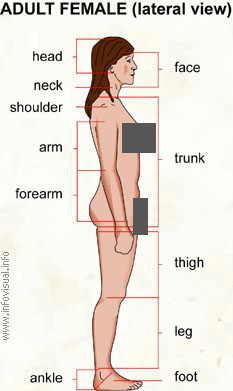Adult female (lateral view)

Face: front part of a humand head.
Trunk: central part of the body.
Thigh: upper part of the lower limb of humans.
Leg: lower part of the lower limb of humans.
Foot: part of the lower limb of a human that supports its weight when it is standing.
Ankle: joint connecting the leg to the foot.
Forearm: part of the upper limb between the wrist and the elbow.
Arm: part of the upper limb between the elbow and the shoulder.
Shoulder: joint connecting the arm to the trunk.
Neck: part of a human being between the trunk and the head; the neck supports the head.
Head: upper part of the body, comprising the face and the skull.
Photo :

Domestic goats are one of the oldest domesticated species. For thousands of years, goats have been used for their milk, meat, hair, and skins all over the world. Most goats naturally have two horns, of various shapes and sizes depending on the breed. While horns are a predominantly male feature, some breeds of goats have horned females. Polled (hornless goats) are not uncommon and there have been incidents of polycerate goats (having as many as eight horns), although this is a genetic rarity thought to be inherited. Their horns are made of living bone surrounded by keratin and other proteins and are used for defense, dominance, and territoriality.
Goats are ruminants. They have a four-chambered stomach consisting of the rumen, the reticulum, the omasum, and the abomasum. Goats have horizontal slit-shaped pupils, an adaptation which increases peripheral depth perception. Because goats' irises are usually pale, the pupils are much more visible than in animals with horizontal pupils but very dark irises, such as sheep, cattle and most horses.
Both male and female goats have beards, and many types of goats may have wattles, one dangling from each side of the neck. Some breeds of sheep and goats appear superficially similar, but goat tails are short and point up, whereas sheep tails hang down and are usually longer, though some are short, and some long ones are docked.